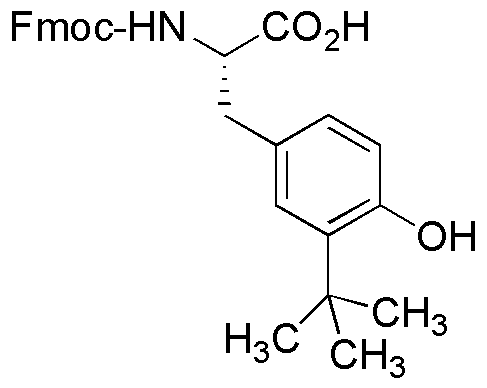Fmoc-L-Tyr(3-tBu)-OH is widely utilized in research focused on:
- Peptide Synthesis: This compound serves as a key building block in the synthesis of peptides, particularly in solid-phase peptide synthesis (SPPS), allowing researchers to create complex peptides for various applications.
- Drug Development: It is used in the development of pharmaceutical compounds, especially those targeting neurological disorders, due to its ability to enhance the stability and bioavailability of peptide drugs.
- Bioconjugation: The chemical is employed in bioconjugation processes, where it helps in attaching peptides to other biomolecules, facilitating the creation of targeted drug delivery systems.
- Research in Cancer Therapy: Researchers utilize this compound to develop peptide-based therapeutics aimed at cancer treatment, leveraging its properties to improve efficacy and reduce side effects.
- Protein Engineering: It plays a role in protein engineering, where it aids in modifying proteins to enhance their functionality, stability, and interaction with other molecules.
General Information
Properties
Safety and Regulations
Applications
Fmoc-L-Tyr(3-tBu)-OH is widely utilized in research focused on:
- Peptide Synthesis: This compound serves as a key building block in the synthesis of peptides, particularly in solid-phase peptide synthesis (SPPS), allowing researchers to create complex peptides for various applications.
- Drug Development: It is used in the development of pharmaceutical compounds, especially those targeting neurological disorders, due to its ability to enhance the stability and bioavailability of peptide drugs.
- Bioconjugation: The chemical is employed in bioconjugation processes, where it helps in attaching peptides to other biomolecules, facilitating the creation of targeted drug delivery systems.
- Research in Cancer Therapy: Researchers utilize this compound to develop peptide-based therapeutics aimed at cancer treatment, leveraging its properties to improve efficacy and reduce side effects.
- Protein Engineering: It plays a role in protein engineering, where it aids in modifying proteins to enhance their functionality, stability, and interaction with other molecules.
Documents
Safety Data Sheets (SDS)
The SDS provides comprehensive safety information on handling, storage, and disposal of the product.
Product Specification (PS)
The PS provides a comprehensive breakdown of the product’s properties, including chemical composition, physical state, purity, and storage requirements. It also details acceptable quality ranges and the product's intended applications.
Certificates of Analysis (COA)
Search for Certificates of Analysis (COA) by entering the products Lot Number. Lot and Batch Numbers can be found on a product’s label following the words ‘Lot’ or ‘Batch’.
*Catalog Number
*Lot Number
Certificates Of Origin (COO)
This COO confirms the country where the product was manufactured, and also details the materials and components used in it and whether it is derived from natural, synthetic, or other specific sources. This certificate may be required for customs, trade, and regulatory compliance.
*Catalog Number
*Lot Number
Safety Data Sheets (SDS)
The SDS provides comprehensive safety information on handling, storage, and disposal of the product.
DownloadProduct Specification (PS)
The PS provides a comprehensive breakdown of the product’s properties, including chemical composition, physical state, purity, and storage requirements. It also details acceptable quality ranges and the product's intended applications.
DownloadCertificates of Analysis (COA)
Search for Certificates of Analysis (COA) by entering the products Lot Number. Lot and Batch Numbers can be found on a product’s label following the words ‘Lot’ or ‘Batch’.
*Catalog Number
*Lot Number
Certificates Of Origin (COO)
This COO confirms the country where the product was manufactured, and also details the materials and components used in it and whether it is derived from natural, synthetic, or other specific sources. This certificate may be required for customs, trade, and regulatory compliance.


